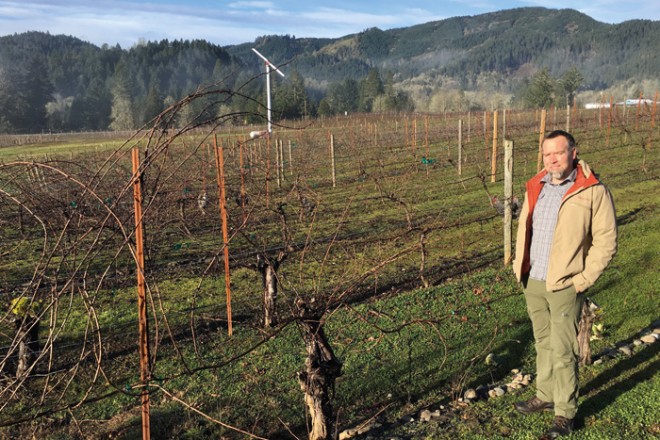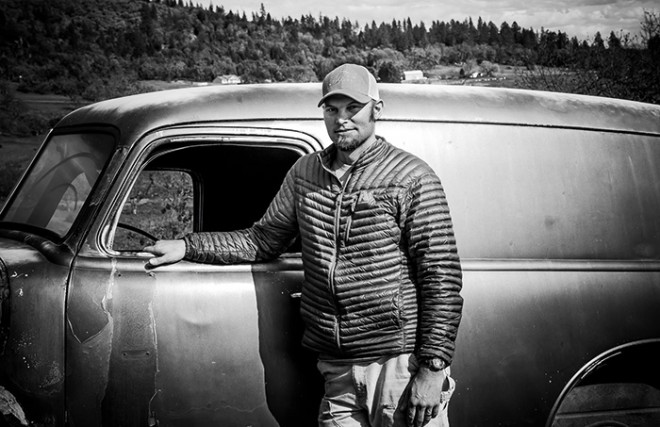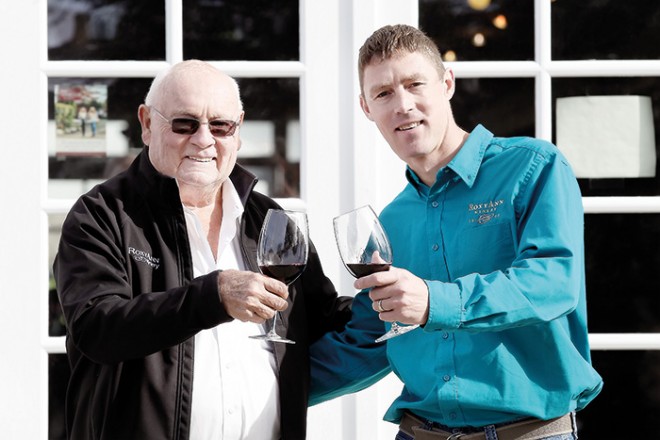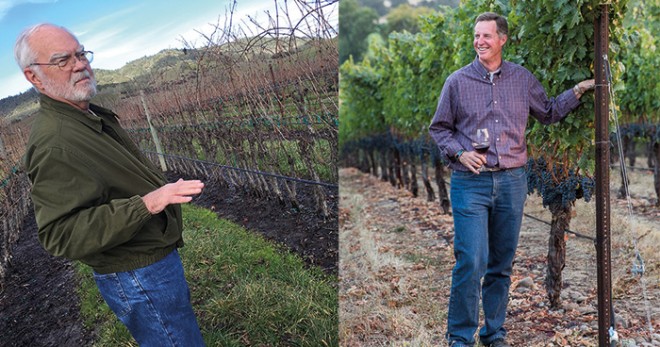With the Willamette Valley producing the most wine of any Oregon AVA, and for over 20 years garnering justifiable worldwide praise for its Pinot Noirs, it’s easy to overlook what else it does and where it does it.

In its southern reaches lie the somewhat warmer and higher altitude valleys of Rogue, with Illinois and Applegate as sub-appellations, and the lower elevation Umpqua. These sustain a wide array of varieties including increasingly appreciated plantings of Tempranillo. Orchard fruit farmers have transitioned into winegrowers learning slowly which varieties to grow. Winemaking has shifted from those who’d no training to the next generation who’ve learned from these pioneers, receiving technical training, and from outsiders arriving with new ideas.
Over a bottle of savory 2006 Cabernet Franc, Eric Weisinger admitted “wine is professionally all I know, so I tell our story while creating a sustainable business.” Wandering scion of a Texas ranching family, his father in 1978 planted an acre of own-rooted Gewurztraminer—still in production as Rogue Valley’s oldest continuous vineyard—his 2400ft. elevation site is amongst Rogue’s highest. “With a 72hr. window to target optimum ripeness we pay great attention to picking schedule.” Weisinger’s house style for whites—including Viognier and Sauvignon Blanc—is bone dry, taut finishing. Weisinger’s Tempranillo commitment extends to a nascent project in his Texan ancestral home.
Kriselle Cellars’s owner/winemaker Scott Steingraber pointed at the receded Rogue River banks, saying the 1300ft. elevation is traditionally the warmest part of the valley allowing better results for late ripeners in avoiding spring frosts. He’s planted three hectares of Cabernets, Merlot, Malbec and Tempranillo upon integrated cobblestone and silty soils in addition to the 16 contiguous hectares planted to Sangiovese, Albarino, Grenache, Sauvignon Blanc, and Viognier. One of the standout wines tasted on this trip was his 2013 Estate Tempranillo—very good now but will benefit from a decade’s aging.

The development of Tempranillo in southern Oregon allows Rob Folin to avoid copying the success of Willamette Valley, preferring to identify differences between them. “I’d rather take chances, something which always allows me to know with what I’ve to work.” Previously at the famous Domaine Serene where he had unlimited technical support and the ability to discern between many different blocks of Pinot Noir, he created wines tailored to changing market demands. Of his Folin Cellars Tempranillos the 2012 Reserve—aged 3 years in new American oak—had great fruits and earth characteristics, an attention-grabber now and structured to age several years.

Small contrast to this is Chad Day of RoxyAnn Vineyards. The former Seattle construction manager returned to his 1400-1500ft. elevation, clay/sandstone soiled family farm where in 2012 he planted Pinot Noir «because it’s a foot in the door for many Oregon wineries, even this far south.” RoxyAnn’s strength are in its whites, Chardonnay in particular, though Day has a good American oak-aged Claret upon which he’s successfully staked his reputation. As at Kriselle he successfully chooses to blend most of his Tempranillo with a small amount of Cabernet Sauvignon.
220km north of Rogue is its sister AVA of Umpqua Valley. Regional weather follows the course of the Umpqua river with the Pacific influence following the river’s course south. “Umpqua has many small valleys with cool airs coming in not only from the ocean but also from the eastern Cascades mountains,” stated Scott Kelley of Paul O’Brien. “There are many opportunities to pick & choose great Tempranillo and other varieties from so many talented grapegrowers.”

Inspired by time in Spain enjoying its wines, Earl Jones planted three clones of Tempranillo culled from UC-Davis in 1993 at Abacela. Now growing 38 hectares of several Spanish varieties, he determined this climate enough like Ribera del Duero that it could be the best US locale for Tempranillo. His premier 1997 bottling was an immediate success with the 1998 besting 20 other US entries at the San Francisco Wine Competition. Wisely planting Albarino on north-facing slopes, Jones’ dedication to Spanish varieties extends to Garnacha, Graciano with a few iterations of Tempranillo. Winemaker Andrew Wenzel has learned to press juice off skins earlier to mitigate tannin extraction and preserve fruitiness. “We’ve had a lot of Spaniards sniffing around here including several working interns,” commented Jones but vineyard manager Chris Lake chimed in that “Europeans coming to buy land to make wine have stayed to Willamette Valley.”
Jim & Terri Delfino live at their 10 hectare vineyard, three planted to Tempranillo since 2002 with cuttings from Abacela. “Earl encouraged me to take clones 1 and 2, changing our minds about following the Pinot Noir route with which Oregon had already succeeded,” said Jim. “We don’t push it hard, but find ourselves talking more about Tempranillo to sell it,” over their Cabernet Sauvignon and Müller-Thurgau. “The percentage of people coming here specifically for Temp has slowly increased.”
In 1971 Marc Girardet’s parents planted several own-rooted varieties; many original Chardonnay and Cabernet Sauvignon vines are still in production. His 12 hectares are dry-farmed, and eschewing pesticides he relies upon a diversity of farm fowl to eat insects. Over a decade he followed his parents in adding yeasts but as of 2016 has gone the way of adding none. All whites are whole-cluster fermentated; “I don’t like the phenolics or bitterness that can come from skin-contacted whites,” while his reds are aged at least 18 months in used French oak. He’s proud of his first Teroldego, inspired by a bottle of Foradori he enjoyed in 2009, while I found greater pleasure in his 2013 ‘Bush Vine’ Tempranillo grown upon gravelly loam and sedimentary shale subsoils.
Oriented toward Hungarian varietals, TeSóAria Winery’s John Olson grows 25 varieties on sandy-clay river bottom soils, pushing whites early to maximize fruitiness while going slower on reds in an effort to extract concentration and aging. “We make small batches of Tempranillo and not every year though we currently have some aging in barrels. Memorable was his still 2015 Vermentino though he also makes a bubbly version.
Other southern Oregon wineries with impressive Tempranillos are Belle Fiore, Plaisance Ranch, and Red Lily.
David Furer